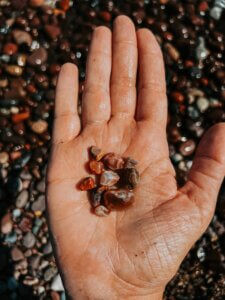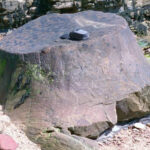Are you curious about identifying agates in your rock collection? Telling if a rock is an agate involves looking for specific characteristics, and at rockscapes.net, we’re here to guide you through the process with expert tips. We provide a solution for easy identification of agates with an emphasis on the unique features of these rocks. Learn to distinguish agates from other stones with confidence using our resources on mineral identification, gemstone characteristics, and rockhounding tips.
1. What Exactly Is An Agate And Why Are They Special?
An agate is a microcrystalline variety of quartz, characterized by its fine grain and distinctive banding patterns. Agates are special because each one is unique, with a variety of colors, patterns, and inclusions that tell a story of the earth’s geological processes. These captivating gemstones are formed within volcanic or metamorphic rocks, where silica-rich groundwater seeps into cavities and slowly deposits layers of chalcedony.
According to research from Arizona State University’s School of Earth and Space Exploration, the unique banding in agates is a result of variations in the concentration of minerals and trace elements during formation. The presence of iron oxide, for example, can create red and orange bands, while manganese oxide can produce black or brown layers. This geological process results in the stunning variety of colors and patterns that make agates so highly prized by collectors and jewelry makers.
2. What Are The Primary Characteristics To Look For In An Agate?
The primary characteristics to look for in an agate are its banding, translucency, hardness, and luster. Agates typically display concentric layers of different colors, which is the most distinguishing feature. When held up to the light, an agate often appears translucent, allowing light to pass through its layers. They have a hardness of around 6.5 to 7 on the Mohs scale and exhibit a waxy to glassy luster when polished.
2.1. How Do The Banding Patterns Help In Identification?
Banding patterns are a crucial indicator of an agate; these patterns are formed by layers of microcrystalline quartz that deposit over time. The bands can be straight, curved, or irregular, and they come in a wide range of colors. The regularity and complexity of these bands are what set agates apart from other types of rocks.
2.2. Why Is Translucency Important In Identifying Agates?
Translucency is important because it allows light to penetrate the stone, revealing the internal patterns and colors, enhancing its beauty. While not all agates are highly translucent, the ability to see even a slight glow through the stone is a good indication that you may have found an agate. This feature helps to differentiate agates from opaque stones that do not allow light to pass through.
2.3. What Does The Hardness Of An Agate Tell You?
The hardness of an agate, typically 6.5 to 7 on the Mohs scale, indicates its durability and resistance to scratching. This level of hardness means that an agate can scratch glass, which is a useful test for identification. A stone that is softer than 6.5 may not be an agate, as true agates are relatively hard and resilient.
2.4. How Does Luster Contribute To Agate Identification?
Luster refers to how light reflects off the surface of a mineral. Agates typically have a waxy to glassy luster, which gives them a smooth, polished appearance. This luster is a result of the fine-grained nature of the microcrystalline quartz that makes up the agate. The way light plays across the surface can help you distinguish an agate from other rocks with a duller or more metallic appearance.
3. Where Are Agates Commonly Found?
Agates are commonly found in areas with a history of volcanic activity, as they form within the vesicles (gas bubbles) of lava flows. Prime locations include beaches and riverbeds where erosion has exposed these stones. Some well-known agate-hunting spots are the Lake Superior region, Brazil, Uruguay, Mexico, and various locations in the western United States.
3.1. Why Are Volcanic Regions Ideal For Finding Agates?
Volcanic regions are ideal because the silica-rich fluids needed for agate formation are readily available in these environments. The gas bubbles in lava flows create the perfect cavities for agate formation, and the surrounding rock provides the necessary minerals and trace elements to create the unique colors and patterns seen in agates. Over millions of years, erosion exposes these agates, making them accessible to collectors.
3.2. How Do Beaches And Riverbeds Help In Discovering Agates?
Beaches and riverbeds help in discovering agates because they act as natural sorting mechanisms. The constant action of water and waves erodes the surrounding rock and washes away lighter materials, leaving behind denser stones like agates. The tumbling action of the water also polishes the agates, making their colors and patterns more visible and easier to identify.
3.3. What Makes The Lake Superior Region A Hotspot For Agate Collectors?
The Lake Superior region is a hotspot due to its unique geological history, characterized by ancient volcanic activity. The lava flows in this area created numerous vesicles that later filled with silica-rich fluids, forming the distinctive Lake Superior agates. These agates are known for their vibrant colors, intricate banding patterns, and durability, making them highly sought after by collectors. The beaches along Lake Superior, such as those near Ironwood, Michigan, are particularly productive.
 Lake Superior agates
Lake Superior agates
3.4. Are There Specific Geological Features That Indicate Agate Presence?
Yes, specific geological features that indicate agate presence include the presence of volcanic rock formations like basalt and rhyolite, as well as areas with hydrothermal activity. These conditions provide the necessary silica and cavities for agate formation. Additionally, areas with sedimentary rocks that have been subjected to metamorphism can also contain agates, as the metamorphic process can concentrate minerals and create suitable environments for agate development.
4. What Are The Different Types Of Agates One Might Encounter?
One might encounter a variety of agates, each with unique characteristics. Common types include banded agates, which feature concentric layers of color; fortification agates, with angular patterns resembling fort walls; eye agates, displaying circular “eye” patterns; and moss agates, containing inclusions that look like moss or plant life. Other types include plume agates, tube agates, and iris agates, each with distinctive visual features.
4.1. How Do Banded Agates Differ From Other Varieties?
Banded agates differ from other varieties primarily in their distinct, layered patterns. These patterns are formed by the successive deposition of silica-rich solutions within a cavity, creating concentric bands of varying colors and textures. Unlike moss agates, which have inclusions, or plume agates, which have feather-like patterns, banded agates are defined by their clear, defined bands.
4.2. What Distinguishes Fortification Agates From Banded Agates?
Fortification agates are distinguished from banded agates by their angular, zig-zagging patterns, which resemble the walls of a fort. While banded agates have smooth, curved layers, fortification agates feature sharp, geometric shapes that create a unique visual effect. This difference in pattern formation is due to variations in the conditions during the agate’s development.
4.3. Why Are Moss Agates Popular Among Collectors?
Moss agates are popular among collectors because of their unique and beautiful inclusions, which resemble moss or other plant-like growths. These inclusions are typically composed of minerals such as iron or manganese oxides, which seep into the agate and create dendritic patterns. The natural, organic appearance of moss agates makes them highly prized for jewelry and display.
4.4. What Are Some Lesser-Known Types Of Agates Worth Looking For?
Some lesser-known types of agates worth looking for include iris agates, which display a rainbow effect when light passes through them, and tube agates, which contain hollow tubes or channels within the stone. Laguna agates from Mexico are also highly valued for their intricate banding and vibrant colors, and scenic agates, which feature patterns that resemble landscapes, are particularly rare and desirable.
5. What Tools And Techniques Are Helpful In Identifying Agates?
Helpful tools and techniques in identifying agates include a magnifying glass for examining banding patterns, a light source to check for translucency, and a hardness testing kit to assess scratch resistance. Cleaning the rock thoroughly can also reveal hidden details. For more advanced identification, a geological field guide and comparison with known samples can be beneficial.
5.1. How Can A Magnifying Glass Assist In Agate Identification?
A magnifying glass assists in agate identification by allowing you to closely examine the fine details of the banding patterns and any inclusions present. This can help you distinguish between true agate banding and similar patterns in other types of rocks. A magnifying glass can also reveal the texture and structure of the agate’s surface, providing additional clues to its identity.
5.2. Why Is A Light Source Essential For Agate Identification?
A light source is essential because it allows you to check for translucency, a key characteristic of agates. By holding the stone up to a light, you can see if light passes through it, revealing internal patterns and colors. This is particularly useful for identifying agates that may appear opaque on the surface but have translucent areas within.
5.3. How Does A Hardness Testing Kit Aid In Identifying Agates?
A hardness testing kit aids in identifying agates by allowing you to assess the stone’s scratch resistance. Agates typically have a hardness of 6.5 to 7 on the Mohs scale, meaning they can scratch glass. By using the tools in the kit to test the stone’s hardness, you can confirm whether it falls within the expected range for agates and rule out softer or harder minerals.
5.4. What Role Does Cleaning Play In Identifying Agates?
Cleaning plays a crucial role by removing dirt, debris, and surface coatings that can obscure the agate’s true characteristics. A clean stone allows you to more clearly see the banding patterns, translucency, and luster that are essential for identification. Simple washing with soap and water, or more aggressive cleaning with a brush, can make a significant difference in revealing the agate’s features.
6. Are There Any Common Misconceptions About Agates?
Yes, some common misconceptions about agates include the belief that all banded rocks are agates, or that the presence of any color or pattern automatically indicates an agate. Another misconception is that agates are always translucent. It’s also often mistaken that all agates are valuable or rare. Proper identification requires considering multiple characteristics and understanding the context of where the rock was found.
6.1. Why Is It Wrong To Assume All Banded Rocks Are Agates?
It is wrong to assume all banded rocks are agates because banding can occur in other types of minerals and rocks as well. For example, some types of jasper and chert can also exhibit banding patterns, but they lack the translucency and specific microcrystalline structure of agates. Accurate identification requires considering the combination of banding, translucency, hardness, and luster, rather than relying solely on the presence of bands.
6.2. Can Color Alone Determine If A Rock Is An Agate?
No, color alone cannot determine if a rock is an agate. While agates can display a wide range of colors, including reds, oranges, yellows, blues, and greens, color is not a definitive characteristic. Other minerals and rocks can also exhibit similar colors, so it’s essential to consider other factors like banding, translucency, and hardness to accurately identify an agate.
6.3. Is Translucency Always Present In Agates?
Translucency is not always present in agates to the same degree. While many agates exhibit some level of translucency, the degree can vary depending on the thickness of the stone and the presence of inclusions or impurities. Some agates may appear almost opaque, while others are highly translucent. Therefore, while translucency is a helpful indicator, it should not be the only factor used for identification.
6.4. Are All Agates Considered Valuable?
No, not all agates are considered valuable. The value of an agate depends on several factors, including its size, color, pattern, and overall quality. Agates with rare or unique patterns, vibrant colors, or exceptional clarity are generally more valuable than common or less attractive specimens. The demand from collectors and jewelers also influences the market value of different types of agates.
7. What Are The Best Times And Conditions For Hunting Agates?
The best times for hunting agates are after a heavy rain or storm, as the water washes away surface debris and exposes new stones. Cloudy days can also be ideal, as they reduce glare and make it easier to spot the subtle colors and patterns of agates. Low-tide conditions on beaches can reveal previously submerged areas where agates may be concentrated.
7.1. Why Are Post-Storm Conditions Ideal For Agate Hunting?
Post-storm conditions are ideal because the heavy rain and waves dislodge rocks and minerals from their usual spots, bringing them to the surface. The water action washes away sand and other debris, making it easier to spot agates among the newly exposed stones. This is a prime time to find agates that were previously hidden.
7.2. How Does Cloud Cover Enhance Agate Visibility?
Cloud cover enhances agate visibility by reducing glare from the sun, which can make it difficult to see the subtle colors and patterns of agates. On a cloudy day, the light is more diffused, allowing you to more easily spot the unique characteristics that distinguish agates from other rocks.
7.3. What Advantages Do Low-Tide Conditions Offer Agate Hunters?
Low-tide conditions offer agate hunters the advantage of accessing areas that are normally submerged under water. These areas may contain agates that have been deposited by wave action and have not been disturbed by previous collectors. Exploring these newly exposed areas can increase your chances of finding unique and valuable agates.
7.4. Are There Specific Seasonal Considerations For Agate Hunting?
Yes, there are specific seasonal considerations for agate hunting. In colder climates, the spring thaw can be a great time to find agates as melting snow and ice uncover new stones. In warmer regions, the dry season may be preferable as water levels in rivers and lakes are lower, exposing more shoreline. Also, avoid agate hunting during times when vegetation is overgrown, as this can make it more difficult to spot stones.
8. How Do Experienced Rockhounds Identify Agates Quickly?
Experienced rockhounds identify agates quickly by developing a “trained eye” that recognizes the subtle characteristics of these stones. They focus on key features such as banding patterns, translucency, and luster, and can quickly assess whether a rock is likely to be an agate. Their experience also allows them to identify promising locations and conditions for finding agates.
8.1. What Is The Role Of A “Trained Eye” In Agate Identification?
The role of a “trained eye” is crucial, as it enables rockhounds to quickly assess the visual cues that indicate the presence of an agate. This involves recognizing the specific banding patterns, colors, and translucency that are characteristic of agates. Over time, experienced rockhounds develop an intuitive sense for identifying agates, even among a pile of similar-looking rocks.
8.2. How Does Experience Influence Agate Hunting Success?
Experience significantly influences agate hunting success by helping rockhounds to identify promising locations, understand optimal conditions, and quickly distinguish agates from other rocks. Experienced hunters know where to look, when to look, and what to look for, increasing their chances of finding valuable and unique specimens.
8.3. Are There Any Mental Checklists Rockhounds Use For Identification?
Yes, there are mental checklists rockhounds use for identification, which typically include assessing the rock’s shape, size, color, banding patterns, translucency, luster, and hardness. They also consider the geological context of where the rock was found, such as whether it is in a volcanic region or near a riverbed. By systematically evaluating these characteristics, they can quickly determine whether a rock is likely to be an agate.
8.4. Can You Learn To “Think Like An Agate”?
While you can’t literally “think like an agate,” you can learn to understand the geological processes that lead to agate formation and use that knowledge to improve your hunting skills. This involves studying the environments where agates are found, understanding the conditions that favor their formation, and recognizing the types of rocks and minerals that are commonly associated with agates. By developing this understanding, you can better predict where agates are likely to be found and increase your chances of success.
9. What Safety Precautions Should Be Taken While Hunting For Agates?
Safety precautions while hunting for agates include wearing appropriate footwear to protect against sharp rocks, being aware of the tides and weather conditions, and carrying water to stay hydrated. It’s also wise to inform someone of your plans and location, and to avoid trespassing on private property. Be cautious of slippery surfaces and unstable terrain, and always be respectful of the environment.
9.1. Why Is Appropriate Footwear Important For Agate Hunting?
Appropriate footwear is crucial because agate hunting often involves walking on uneven, rocky terrain. Sturdy shoes or boots with good ankle support can protect your feet from sharp rocks and prevent injuries such as sprains or cuts. Proper footwear also provides better traction, reducing the risk of slips and falls.
9.2. How Can Tide Awareness Prevent Accidents?
Tide awareness can prevent accidents by ensuring that you are not caught off guard by rising water levels, which can quickly isolate you on a beach or rocky outcrop. Before heading out, check the tide charts for the area and be aware of the predicted high and low tides. Pay attention to the changing water levels and be prepared to move to higher ground if necessary.
9.3. What Role Does Hydration Play In Safe Agate Hunting?
Hydration plays a vital role in safe agate hunting, especially in hot or sunny conditions. Dehydration can lead to fatigue, dizziness, and heatstroke, which can impair your judgment and increase the risk of accidents. Carry plenty of water with you and drink regularly, even if you don’t feel thirsty.
9.4. Why Is It Important To Be Aware Of The Weather Forecast?
It is important to be aware of the weather forecast because sudden changes in weather conditions can pose serious risks to agate hunters. Storms, heavy rain, or strong winds can create hazardous conditions, making it difficult to navigate rocky terrain or increasing the risk of being caught in a dangerous situation. Check the forecast before heading out and be prepared to change your plans if necessary.
10. How Can Rockscapes.Net Help You In Your Agate Hunting Journey?
Rockscapes.net can greatly assist you in your agate hunting journey by providing detailed information on different types of agates, their geological origins, and the best locations to find them. We offer expert tips on identification, tools, and techniques, as well as safety precautions. Our extensive resources and community forums can enhance your knowledge and connect you with other enthusiasts.
10.1. What Specific Information On Agates Does Rockscapes.Net Offer?
Rockscapes.net offers specific information on agates, including their formation, types, characteristics, and locations. You’ll find detailed guides on identifying agates, recognizing different banding patterns, and understanding their geological context. Our resources also cover the tools and techniques needed for successful agate hunting, as well as tips on cleaning, preserving, and displaying your finds.
10.2. How Does Rockscapes.Net Assist In Identifying Agates?
Rockscapes.net assists in identifying agates by providing visual guides, detailed descriptions, and comparison charts that highlight the key characteristics of different agate types. Our expert advice helps you distinguish agates from other similar-looking rocks and minerals. We also offer a community forum where you can share photos of your finds and get feedback from experienced rockhounds.
10.3. What Tools And Techniques Are Recommended By Rockscapes.Net?
Rockscapes.net recommends a range of tools and techniques for successful agate hunting, including using a magnifying glass to examine banding patterns, a light source to check for translucency, and a hardness testing kit to assess scratch resistance. We also provide tips on cleaning and preparing your finds, as well as advanced techniques for identifying rare or unusual agates.
10.4. How Can The Rockscapes.Net Community Enhance Your Agate Hunting Experience?
The Rockscapes.net community can enhance your agate hunting experience by connecting you with other enthusiasts, sharing tips and insights, and providing feedback on your finds. You can join discussions, ask questions, and learn from the experiences of others. Our community is a valuable resource for both beginners and experienced rockhounds, offering support, encouragement, and a shared passion for agate hunting.
Address: 1151 S Forest Ave, Tempe, AZ 85281, United States.
Phone: +1 (480) 965-9011.
Website: rockscapes.net.
 Ironwood Beaches
Ironwood Beaches
Ready to start your agate hunting adventure? Visit rockscapes.net today to explore a wealth of information, stunning design ideas, and expert advice. Uncover the secrets of landscape design and transform your outdoor spaces with the beauty of natural stone. Let rockscapes.net be your trusted partner in creating breathtaking rockscapes that capture the essence of nature’s artistry.
Frequently Asked Questions About Agate Identification
1. Can agates be found in any type of rock?
Agates are most commonly found in volcanic rocks like basalt and rhyolite, but they can also occur in sedimentary rocks that have undergone metamorphism.
2. What makes the banding patterns in agates so unique?
The banding patterns in agates are created by the successive deposition of silica-rich solutions, with varying concentrations of minerals and trace elements, within a cavity over time.
3. Is it possible to find agates in urban environments?
While less common, agates can sometimes be found in urban environments where gravel or landscaping materials have been sourced from areas with agate-bearing rocks.
4. What’s the best way to clean an agate to enhance its appearance?
The best way to clean an agate is to scrub it gently with a soft brush and soapy water. For more stubborn dirt or stains, you can use a mild acid solution, but be sure to rinse it thoroughly afterward.
5. How can I tell if an agate has been artificially enhanced?
Signs of artificial enhancement include unusually vibrant or unnatural colors, as well as a waxy or plastic-like coating on the surface of the stone.
6. Are agates always smooth to the touch?
While many agates are smooth, some may have a rough or textured surface due to the presence of inclusions or incomplete polishing.
7. What is the difference between an agate and a geode?
An agate is a type of chalcedony with distinct banding patterns, while a geode is a hollow rock or mineral formation that contains crystals or other mineral deposits.
8. Can agates be found in other colors besides the typical reds and oranges?
Yes, agates can be found in a wide range of colors, including blues, greens, purples, and even black and white.
9. What are some of the most sought-after types of agates for collectors?
Some of the most sought-after types of agates for collectors include Laguna agates, Brazilian agates, and Lake Superior agates, known for their unique colors, patterns, and clarity.
10. How can I display my agate collection to best showcase their beauty?
You can display your agate collection in a variety of ways, such as in display cases, on shelves, or even incorporated into jewelry or other decorative items. Be sure to provide adequate lighting to showcase their colors and patterns.

